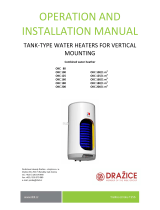- 10 -
8.3 HEATING UNIT ASSEMBLY
Aside from the installation regulations, the conditions of connection resulting from local distribution
and water supply plants must be followed:
1. Remove protective cover (position 1)
2. The variant TPK 150-8 and TPK 168-8 requires to fit sealing on the screws, place the heating flange
(position 2) and screw on the screws in the flange above the tanks (torque 15 Nm). The variant TPK
210-12 requires to screw 3 auxiliary threaded bars M12x50 evenly on the periphery into 3 threaded
holes. Fit on the sealing and place the heating flange (position 2). Then screw the remaining 9 screws
M12x30 and fasten it with a cross (torque 15 Nm). Then unscrew the threaded bars and replace them
with the remaining 3 screws M12x30 and fasten it (torque 15 Nm).
3. Carry out electric connection following the scheme (see point 8.5). Warning - do not forget to connect
the guard wire. With flanges with selectable output, interconnect the terminal boards to the required
output.
4. Put on the protective guard and thermostat control. Cover the gap between the heater shell
and flange guard with the attached profile.
5. Commissioning is possible solely when the tank is filled with water.
Heating element assembly and its initial operation can only be implemented by an expert, who takes
responsibility for proper implementation and equipment.
The space in front of the electrical heating unit equal to the installation length + 50 mm must be left free
for installation, etc.
8.4 ELECTRICAL CONNECTION
The electrical connection must be implemented based on the attached scheme. The scheme is placed inside
the plastic cover of the heating flange, and it relates to the specific type!
The network voltage must be respected!
All metal parts of the accumulator must meet relevant protective regulations.
Notice: Perform the installation in compliance with applicable CSN standards.
All switches must be connected to circuit breakers. The supply cable must be supplied into the area of
connection via a sealing bushing and secured from shifting, wringing, and tearing out by a clamp.

















